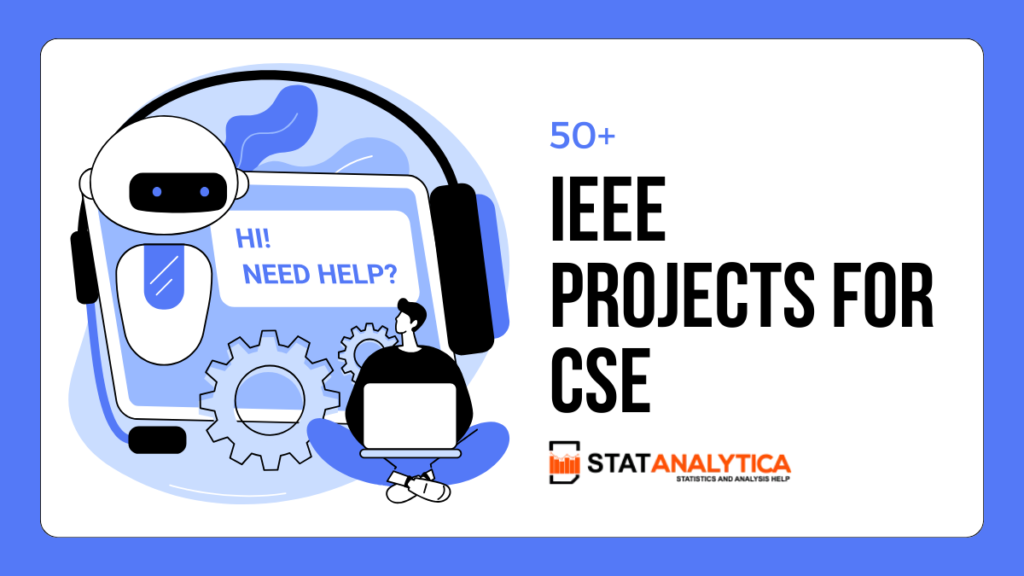In the dynamic realm of Computer Science Engineering (CSE), staying updated about the latest developments is essential for students to thrive in their academic and professional journeys. One key avenue for this exploration is engaging in IEEE (Institute of Electrical and Electronics Engineers) projects tailored for CSE students. This blog aims to provide a comprehensive guide on IEEE projects for CSE, helping students understand the importance of choosing the right projects and navigating the complexities of implementation.
What are IEEE Standards?
Table of Contents
IEEE, as a globally recognized authority in technology standards, plays a pivotal role in shaping the landscape of CSE projects. Its standards not only ensure the quality of projects but also contribute to the seamless integration of technological advancements.
By adhering to IEEE standards, CSE students can enhance the credibility and reliability of their projects, making them valuable assets in the academic and professional spheres.

How to Select the Right IEEE Project?
Selecting the right IEEE project is a critical step in a student’s academic and professional journey. Here’s a step-by-step guide to help you navigate this process:
- Identify Your Interests and Strengths:
- Consider your passions within the vast field of Computer Science.
- Assess your skills and strengths to determine areas where you excel.
- Stay Updated on Industry Trends:
- Keep abreast of current trends and emerging technologies in Computer Science Engineering.
- Choose a project that aligns with the latest advancements in the industry.
- Evaluate Project Relevance:
- Assess the practicality and relevance of potential projects in real-world scenarios.
- Opt for projects that address current challenges or contribute to industry needs.
- Understand Project Scope and Complexity:
- Gauge the complexity of projects and ensure it aligns with your skill level.
- Consider the time and resources required to complete the project successfully.
- Explore IEEE Project Databases:
Utilize IEEE databases and resources to explore a variety of project options.
Narrow down projects that match your interests and align with your academic goals.
- Consult with Mentors and Peers:
- Seek guidance from professors, mentors, or peers who can provide valuable insights.
- Discuss your interests and goals to receive recommendations tailored to your profile.
- Consider Personal and Academic Goals:
- Align the chosen project with your academic objectives and career aspirations.
- Ensure the project contributes to your skill development and overall growth.
- Evaluate Resource Availability:
- Assess the availability of resources, including hardware, software, and expertise.
- Choose a project that can be feasibly implemented with the resources at your disposal.
- Assess Project Impact:
- Consider the potential impact of the project on your academic and professional portfolio.
- Choose projects that showcase your abilities and contribute meaningfully to your field.
- Plan for Continuous Learning:
- Opt for projects that offer opportunities for continuous learning and skill enhancement.
- Embrace challenges that push you to expand your knowledge and capabilities.
Remember, the right IEEE project for CSE students should align with their interests, match their skill level, contribute to their academic and career goals, and be feasible within the available resources. By following these steps, you can make an informed decision and embark on a rewarding project journey.
| Also Read:- Marketing Project Ideas For College Students |
50+ IEEE Projects for CSE [Category Wise]
Machine Learning and AI Projects
- Image Recognition using Convolutional Neural Networks (CNN)
- Natural Language Processing (NLP) for Sentiment Analysis
- Predictive Analytics for Stock Market Trends
- Autonomous Vehicle Navigation using Reinforcement Learning
Data Science and Big Data Projects
- Predictive Analytics for Disease Outbreaks
- Fraud Detection in Financial Transactions
- Social Media Analytics for User Behavior Prediction
- Large-scale Data Processing with Hadoop and Spark
Cyber Security Projects
- Intrusion Detection System using Machine Learning
- Blockchain-Based Secure Healthcare Records
- Biometric Authentication Systems
- Network Security Monitoring and Analysis
Internet of Things (IoT) Projects
- Smart Home Automation System
- Industrial IoT for Predictive Maintenance
- Healthcare Monitoring using IoT Devices
- Energy Management in Smart Cities
Cloud Computing Projects
- Cloud-Based E-Learning System
- Resource Allocation in Cloud Computing
- Cloud Security and Encryption
- IoT Integration with Cloud Services
Blockchain Projects
- Supply Chain Transparency using Blockchain
- Decentralized Voting System
- Blockchain-Based Identity Management
- Smart Contracts for Legal Processes
Mobile App Development Projects
- Health and Fitness Tracking App
- Augmented Reality (AR) Gaming Application
- Location-Based Services for Tourism
- Secure Messaging App with End-to-End Encryption
Computer Vision Projects
- Human Activity Recognition using Computer Vision
- Object Detection and Tracking in Video Streams
- Facial Recognition for Access Control
- Augmented Reality Applications
Web Development Projects
- Content Recommendation System for Websites
- E-Commerce Platform with Personalized Shopping
- Online Learning Management System
- Social Networking Platform with Advanced Features
Networking Projects
- Software-Defined Networking (SDN) for Improved Network Management
- Quality of Service (QoS) in Wireless Networks
- IoT Communication Protocols
- Network Function Virtualization (NFV) Implementation
Edge Computing Projects
- Real-time Video Analytics at the Edge
- Edge-based Health Monitoring for Remote Areas
- Intelligent Traffic Management using Edge Devices
- Edge Computing for IoT Security
Biomedical Engineering Projects
- Wearable Devices for Continuous Health Monitoring
- Computer-Aided Diagnosis System for Medical Images
- Brain-Computer Interface for Assistive Technology
- Predictive Modeling for Disease Outbreaks in Healthcare
Human-Computer Interaction (HCI) Projects
- Gesture Recognition System for Human-Computer Interaction
- Voice User Interface (VUI) for Smart Assistants
- Augmented Reality (AR) for Enhancing User Experience
- Accessibility Features for Software Applications
Methodology for Implementing IEEE Projects
Implementing IEEE projects in Computer Science Engineering involves a systematic methodology to ensure successful execution. Below is a step-by-step guide that outlines the key phases and considerations in the implementation process:
- Project Selection and Definition:
- Define Clear Objectives: Clearly outline the goals and objectives of the project.
- Choose a Methodology: Select a development methodology (e.g., Waterfall, Agile) based on the project’s nature.
- Literature Review and Research:
- Review Existing Work: Explore relevant literature and existing projects in the chosen domain.
- Identify Gaps and Challenges: Determine gaps in current research and challenges that the project aims to address.
- Requirement Analysis:
- Define User Requirements: Gather and document user requirements comprehensively.
- Create a Functional Specification: Develop a detailed specification document outlining the system’s functionalities.
- Design Phase:
- Architectural Design: Create a high-level architecture and design the system’s structure.
- Detailed Design: Develop detailed designs for each module or component of the project.
- Development:
- Coding: Write code according to the design specifications.
- Use Version Control: Implement version control systems (e.g., Git) to manage code changes.
- Testing:
- Unit Testing: Test individual components to ensure they function as intended.
- Integration Testing: Verify that components work seamlessly together.
- System Testing: Evaluate the system as a whole against defined requirements.
- Documentation:
- Technical Documentation: Create detailed documentation for code, algorithms, and system architecture.
- User Documentation: Develop user manuals and guides for easy system understanding.
- Deployment:
- Prepare for Deployment: Ensure all dependencies are met and system requirements are fulfilled.
- Deploy in Staging Environment: Test the project in a controlled environment before deployment to production.
- Evaluation and Validation:
- Performance Testing: Evaluate the system’s performance under various conditions.
- User Acceptance Testing (UAT): Have end-users validate the system against their requirements.
- Feedback and Iteration:
- Gather Feedback: Collect feedback from users, stakeholders, and testing teams.
- Iterate and Improve: Implement necessary changes based on feedback to enhance the project.
- Final Documentation and Presentation:
- Compile Final Documentation: Update documentation to reflect the final state of the project.
- Prepare for Presentation: Create presentations summarizing the project’s objectives, methodology, and outcomes.
- Knowledge Transfer and Maintenance:
- Knowledge Sharing: Conduct knowledge transfer sessions to share insights with team members or successors.
- Maintenance Plan: Develop a plan for ongoing maintenance and updates, if necessary.
- Publication and Dissemination (Optional):
- Prepare Research Papers: If applicable, document the research findings for publication.
- Present at Conferences: Share project outcomes at relevant conferences or forums.
- Reflect and Learn:
- Post-Implementation Review: Conduct a post-implementation review to identify lessons learned.
- Reflect on Challenges: Assess challenges faced during implementation for future improvement.
By following this comprehensive methodology, you can streamline the implementation process of IEEE projects, ensuring a structured and successful outcome.
Each phase is crucial, and attention to detail in planning, development, testing, and documentation is key to the project’s overall success.
Challenges and Solutions
Embarking on an IEEE project journey is not without its challenges. This section identifies common obstacles that students may encounter during the execution of their projects and offers strategies to overcome them.
Real-life examples of successful project execution serve as inspirations, demonstrating that challenges can be surmounted with perseverance, creativity, and strategic problem-solving.
Conclusion
In conclusion, navigating the world of IEEE projects for CSE offers students a pathway to not only enhance their academic knowledge but also to contribute meaningfully to the ever-evolving field of technology.
By understanding IEEE standards, choosing the right projects, overcoming challenges, and embracing the benefits, students can position themselves as leaders in the dynamic and exciting realm of Computer Science Engineering.
The future holds limitless possibilities, and IEEE projects serve as a gateway to unlocking the potential of aspiring CSE professionals.
We hope this blog gave you valuable insights on the topic! Now, we’d like to share that we also offer the Best Assignment Help and Homework Help services. From statistics to topics across all study fields, our expert team is here to deliver accurate, timely, and reliable solutions. Click here to learn more!


